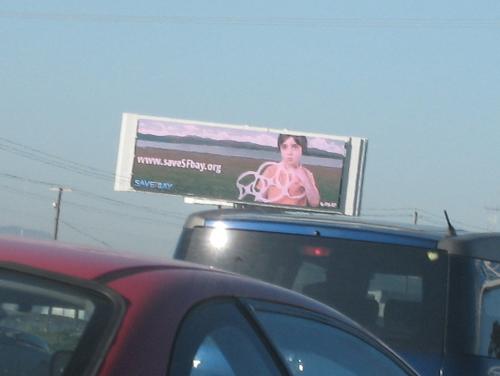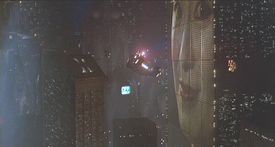I drive the Bay Bridge just about every work day. I'm not proud of this fact. I never expected to be one of those dreaded suburban commuters, living off urban sprawl, the sole occupant of a compact car inching through rush hour traffic twice a day.So sue me. Or better yet, give me enough money to afford a house in San Francisco. Until then, Berkeley it is.But on my morning drive last week I saw a new feature amid the landscape of cargo containers that borders the southern side of the Bay Bridge toll plaza—that's on the East Bay side. It was a new billboard, depicted above. I have no idea how it works. But damn, is it bright. It's an active surface—it changes, presumably according to programming, cycling through a bunch of different ads. So what? Well, for one thing, it's the biggest, brightest one of these kind of signs I've ever seen, high resolution and bright enough to be seen in stark California sunlight. And second, it's just another step in the Blade Runnerfication of our cities.Not that there's anything wrong with that. More after the jump.
 I drive the Bay Bridge just about every work day. I'm not proud of this fact. I never expected to be one of those dreaded suburban commuters, living off urban sprawl, the sole occupant of a compact car inching through rush hour traffic twice a day.
I drive the Bay Bridge just about every work day. I'm not proud of this fact. I never expected to be one of those dreaded suburban commuters, living off urban sprawl, the sole occupant of a compact car inching through rush hour traffic twice a day.
So sue me. Or better yet, give me enough money to afford a house in San Francisco. Until then, Berkeley it is.
But on my morning drive last week I saw a new feature amid the landscape of cargo containers that borders the southern side of the Bay Bridge toll plaza-that's on the East Bay side. It was a new billboard, depicted above. I have no idea how it works. But damn, is it bright. It's an active surface-it changes, presumably according to programming, cycling through a bunch of different ads. So what? Well, for one thing, it's the biggest, brightest one of these kind of signs I've ever seen, high resolution and bright enough to be seen in stark California sunlight. And second, it's just another step in the Blade Runnerfication of our cities.
Not that there's anything wrong with that. More after the jump.
I took a bunch of pictures of the sign, at great risk to life and limb. Probably I shouldn't be tinkering with my camera while driving in traffic, is what I'm saying. But look at how amazing this sign is:
 |
 |
It's beautiful. The gantry holding it up has a CBS eye on it, so presumably it's owned by CBS Outdoor, which also runs a lot of the signage in Times Square.
Active surfaces are a signifier of our science fiction future. They were what defined the Blade Runner Los Angeles:
 Though you'll note that all those building-sized animated advertisements only showed at night. Then again, that whole movie took place at night. Cheaper to do the special effects, which were, you'll remember, pre-computer-generated imagery. All miniatures, and mattes. Super cool.
Though you'll note that all those building-sized animated advertisements only showed at night. Then again, that whole movie took place at night. Cheaper to do the special effects, which were, you'll remember, pre-computer-generated imagery. All miniatures, and mattes. Super cool.
I have to admit I was a little disappointed to see the same visual signifiers in an otherwise very nifty movie, Alfonso Cuaron's Children of Men. That first scene, a virtuoso shot following Clive Owen out of a cafe into the street, relies on active surfaces on buildings and buses to convey future-ness in London just like Blade Runner did 25 years ago (yes, it has been that long). That implies, to me, a certain lack of vision...or, alternatively, yet more acceptance that Blade Runner really does depict what the writer Warren Ellis sometimes calls our grim meathook future. Check out his comic book series Transmetropolitan if you want to know what I mean.
So I hereby christen an intermittent, poorly updated, likely-to-vanish-if-I-get-bored feature here on the Interchange: The Blade Runner Watch. Every time I see something in a city that makes the world look more like the movie, I'll post on it. Feel free to contribute; you know how to reach me.

Alabama: Trump Terminates Settlements for Black Communities Harmed By Raw Sewage
Trump deemed the landmark civil rights agreement “illegal DEI and environmental justice policy.”

Planetizen Federal Action Tracker
A weekly monitor of how Trump’s orders and actions are impacting planners and planning in America.

The 120 Year Old Tiny Home Villages That Sheltered San Francisco’s Earthquake Refugees
More than a century ago, San Francisco mobilized to house thousands of residents displaced by the 1906 earthquake. Could their strategy offer a model for the present?

In Both Crashes and Crime, Public Transportation is Far Safer than Driving
Contrary to popular assumptions, public transportation has far lower crash and crime rates than automobile travel. For safer communities, improve and encourage transit travel.

Report: Zoning Reforms Should Complement Nashville’s Ambitious Transit Plan
Without reform, restrictive zoning codes will limit the impact of the city’s planned transit expansion and could exclude some of the residents who depend on transit the most.

Judge Orders Release of Frozen IRA, IIJA Funding
The decision is a victory for environmental groups who charged that freezing funds for critical infrastructure and disaster response programs caused “real and irreparable harm” to communities.
Urban Design for Planners 1: Software Tools
This six-course series explores essential urban design concepts using open source software and equips planners with the tools they need to participate fully in the urban design process.
Planning for Universal Design
Learn the tools for implementing Universal Design in planning regulations.
Clanton & Associates, Inc.
Jessamine County Fiscal Court
Institute for Housing and Urban Development Studies (IHS)
City of Grandview
Harvard GSD Executive Education
Toledo-Lucas County Plan Commissions
Salt Lake City
NYU Wagner Graduate School of Public Service


























